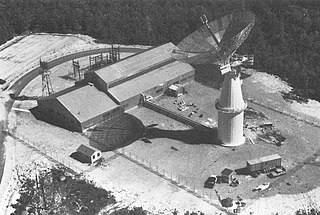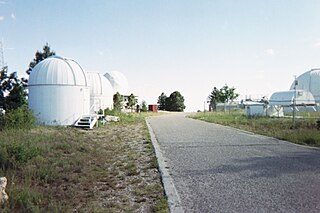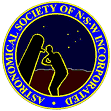Related Research Articles

Radar astronomy is a technique of observing nearby astronomical objects by reflecting radio waves or microwaves off target objects and analyzing their reflections. Radar astronomy differs from radio astronomy in that the latter is a passive observation and the former an active one. Radar systems have been conducted for six decades applied to a wide range of Solar System studies. The radar transmission may either be pulsed or continuous. The strength of the radar return signal is proportional to the inverse fourth-power of the distance. Upgraded facilities, increased transceiver power, and improved apparatus have increased observational opportunities.

The Spitzer Space Telescope, formerly the Space Infrared Telescope Facility (SIRTF), was an infrared space telescope launched in 2003. Operations ended on 30 January 2020. Spitzer was the third space telescope dedicated to infrared astronomy, following IRAS (1983) and ISO (1995–1998). It was the first spacecraft to use an Earth-trailing orbit, later used by the Kepler planet-finder.

The Spacewatch Project is an astronomical survey that specializes in the study of minor planets, including various types of asteroids and comets at University of Arizona telescopes on Kitt Peak near Tucson, Arizona, in the United States. The Spacewatch Project has been active longer than any other similar currently active programs.

Catalina Sky Survey is an astronomical survey to discover comets and asteroids. It is conducted at the Steward Observatory's Catalina Station, located near Tucson, Arizona, in the United States.

Gordon John Garradd is an Australian amateur astronomer and photographer from Loomberah, New South Wales. He has discovered numerous asteroids and comets, including the hyperbolic comet C/2009 P1, and four novae in the Large Magellanic Cloud. The asteroid and Mars-crosser, 5066 Garradd, was named in his honour.
Jeffrey S. Medkeff, usually known as Jeff Medkeff, was a prominent science writer and educator. He was also a designer of robotic telescopes, a minor philanthropist, and an advocate of personal and sexual freedom.

Mount Lemmon Observatory (MLO), also known as the Mount Lemmon Infrared Observatory, is an astronomical observatory located on Mount Lemmon in the Santa Catalina Mountains approximately 28 kilometers (17 mi) northeast of Tucson, Arizona (US). The site in the Coronado National Forest is used with special permission from the U.S. Forest Service by the University of Arizona's Steward Observatory, and contains a number of independently managed telescopes.
James Whitney Young is an American astronomer who worked in the field of asteroid research. After nearly 47 years with the Jet Propulsion Laboratory at their Table Mountain Facility, Young retired July 16, 2009.
John "Jack" Borden Newton is a Canadian astronomer, best known for his publications and images in amateur astrophotography.

The Space Science Institute (SSI) in Boulder, Colorado, is a nonprofit, public-benefit corporation formed in 1992. Its purpose is to create and maintain an environment where scientific research and education programs can flourish in an integrated fashion. SSI is among the four non-profit institutes in the US cited in a 2007 report by Nature, including Southwest Research Institute, Planetary Science Institute, and Eureka Scientific, which manage federal grants for non-tenure-track astronomers.
Donald C. Parker, also known as Don Parker, was an American physician and amateur astronomer, specializing in the research of the Solar System and planetary photography. Many of his over 20,000 images of Mars were used by professional astronomers at NASA, Jet Propulsion Laboratory and some observatories and published in numerous books and journals, including Science and Nature. In 2000 he co-authored the book Introduction to Observing and Photographing the Solar System. He is a past director of the Association of Lunar and Planetary Observers.

Edward Carroll Stone is an American space scientist, professor of physics at the California Institute of Technology, and former director of the NASA Jet Propulsion Laboratory (JPL).

Amy Mainzer is an American astronomer, specializing in astrophysical instrumentation and infrared astronomy. She is the deputy project scientist for the Wide-field Infrared Survey Explorer and the principal investigator for the NEOWISE project to study minor planets and the Near Earth Object Surveyor space telescope mission.

Table Mountain Observatory (TMO) is an astronomical observation facility operated by NASA's Jet Propulsion Laboratory. It is located in Big Pines, California, in Angeles National Forest near Wrightwood, north-northeast of Los Angeles, California, in the United States.
Richard A. Kowalski is an American astronomer who has discovered numerous asteroids and comets, among them, many near-Earth objects.

Macarthur Astronomy Forum is a monthly public forum organised by Macarthur Astronomical Society, providing leading national and international professional astronomers with a platform to address the Forum on topics of astronomical interest; also providing members of the Society and the general public with opportunities to learn and ask questions.

The Astronomical Society of New South Wales (ASNSW) is an amateur astronomy club in the state of New South Wales, Australia. Founded in 1954, the society currently has over 400 members.
Bonnie J. Buratti is an American planetary scientist in the Division of Earth and Space Sciences at the Jet Propulsion Laboratory in Pasadena, California, where she leads the Comets, Asteroids, and Satellites Group. Her research involves the composition and physical properties of planetary surfaces, and volatile transport in the outer solar system.

An astronomical body collided with Jupiter, the largest planet in the Solar System, on March 17, 2016. The object in question has not been confirmed by NASA to be an asteroid or comet, but may be so.

Anne L. Kinney is an American space scientist and educator. Kinney is currently the Deputy Center Director at NASA Goddard Space Flight Center. Previously, she held positions as the head of the Directorate for Mathematical and Physical Sciences (MPS) for the National Science Foundation (NSF), the Chief Scientist of the W.M. Keck Observatory, Director of the Solar System Exploration Division at NASA Goddard Space Flight Center, Director of the Origins Program at NASA Jet Propulsion Laboratory, and Director of the Universe Division at NASA Headquarters. She earned a bachelor's degree in astronomy and physics from the University of Wisconsin-Madison and a doctorate in astrophysics from New York University, and has published more than 80 papers on extragalactic astronomy. She was an instrument scientist for the Faint Object Spectrograph that flew on the Hubble Space Telescope.
References
- 1 2 3 4 5 Jet Propulsion Laboratory People: Stephen Edberg Archived 2010-06-10 at the Wayback Machine
- ↑ Jet Propulsion Laboratory Projects: SIM Lite
- ↑ "Saturn in Your Kitchen and Backyard". Cassini Solstice Mission. Archived from the original on 2009-02-12. Retrieved 2016-01-04.
- ↑ Kahn, Ralph A. "NASA: Practical Uses of Math And Science (PUMAS)". pumas.jpl.nasa.gov. Archived from the original on 2013-08-02. Retrieved 2016-01-01.
- ↑ 3672 Stevedberg (1985 QQ)
- ↑ Harvard-Smithsonian Center for Astrophysics